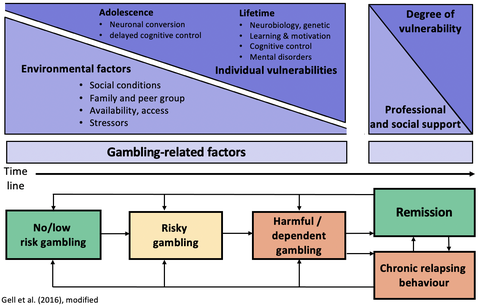Scientific background: Paradigm shift in consumer protection
1. Individual risk factors
The work group's concepts and studies are the result of a paradigm shift in the prevention of gambling disorders: It was previously assumed that all participants in gambling would bear a similar risk for the development of a disorder. Consequently, influencing factors lie predominantly in the range of gambling services and the characteristics of gambling, and prevention takes place primarily through restrictions on these variables (reduction of the range of gambling services, distance regulations, intervention in gambling processes and Internet prohibition). This approach fails to recognise that the proportion of people with a gambling disorder in Germany is very low at around 1% among active players (or 0.5% of the adult population), although gambling is largely equally accessible to all and a large proportion of the adult population participates. This means that there must be individual factors that make players vulnerable to gambling disorder compared to the rest of the group, and that these individual risk factors predominantly increase the likelihood of suffering from a gambling disorder.
This consideration fits well with recent findings in basic research on vulnerability characteristics of people with gambling disabilities, which indicate that this group is at a high risk from the very beginning of the game. Thus the usual preventive measures (education, warning of risks) are not sufficient, vulnerable gamblers need special and early protection. Restricting the availability of gambling would only become preventive for vulnerable players with a drastic reduction as well as high punishment of avoidance behaviour, which would not do justice to the predominant number of social players without problems.
2. Social and gambling factors
The further developed vulnerability-risk model describes as a heuristic concept the occurrence of a gambling disorder as an interaction of biological, psychological and social variables with a varying significance over the life span. Psychosocial factors such as gambling with friends or in the family, social factors such as role models for gambling, advertising as well as characteristics of gambling availability play a role for first-time gambling and the development of risky gambling behaviour and must be considered for prevention among adolescents and young adults. School and parental measures, consistent bans on participation and advertising for this age group are central measures to develop low-risk and risk-conscious participation (Bühringer & Ennuschat, 2016; Bühringer, Kotter & Kräplin, 2017).
The transition from risky gambling to the development of gambling disorders affects players with a genetically or biographically developed vulnerability. The prevention described here is not sufficient; active protective measures from early recognition to gambling break, and gambling exclusion are necessary for this target group (Bühringer, Kotter, Czernecka & Kräplin, 2018).

Heuristic model of the development of harmful gambling
